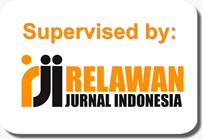ENDOGENEITY TESTING: HEURISTIC BEHAVIOR AS A REFERENCE FOR BEGINNING INVESTORS IN MAKING INVESTMENT DECISIONS
Abstract
This study aims to examine the tendency of endogeneity on heuristic behavior as a reference for novice investors in making investment decisions. Endogeneity is a deviation in OLS modeling which shows that there is still a correlation between the independent variables in the model and the error, causing biased results. The issue of endogeneity is an interesting aspect of current research, and still creates pros and cons for researchers in the fields of finance and econometrics. In this study, 158 respondents were used who were novice investors. The selection of respondents was done randomly. In this study, four categories of variables were used, namely the dependent variable, namely investment decisions, the independent variable, namely financial risk tolerance, endogenous heuristic behavior variables and financial literacy instrument variables. The analysis method is carried out using ivregress 2sls which is processed with Stata. The test results found that endogeneity symptoms were detected in heuristic behavior of novice investors. This behavior appears and influences investment decisions because it is preceded by financial literacy, which rejects the insights that investors have about financial science or investment.
Full Text:
PDFReferences
Ahmad, M., & Shah, S. Z. A. (2020). Overconfidence heuristic-driven bias in investment decision-making and performance: mediating effects of risk perception and moderating effects of financial literacy. Journal of Economic and Administrative Sciences, 38(1), 60–90. https://doi.org/10.1108/jeas-07-2020-0116
Asfira, N., Rokhmawati, A., & Fathoni, ahmad fauzan. (2019). Pengaruh Financial Literacy dan Investment Experience terhadap Risk Tolerance dan Investment Decision. Jurnal Ekonomi Fakultas Ekonomi Dan Bisnis Universitas Riau, 27(4), 340–352.
Braga, R., & Fávero, L. P. L. (2017). Disposition Effect and Tolerance to Losses in Stock Investment Decisions: An Experimental Study. Journal of Behavioral Finance, 18(3), 271–280. https://doi.org/10.1080/15427560.2017.1308946
Cupák, A., Fessler, P., Hsu, J. W., & Paradowski, P. R. (2022). Investor confidence and high financial literacy jointly shape investments in risky assets. Economic Modelling, 116(August). https://doi.org/10.1016/j.econmod.2022.106033
Dewanti, P. W., & Pratiwi, A. A. (2021). The Effect of Heuristics, Herding Behavior, and Financial Literacy on Investment Decisions. Printing World, 282(1), 34–35.
Eker, M., & Anbar, A. (2019). The Effect of Sociodemographic Variables and Love of Money on Financial Risk Tolerance of Bankers. Business and Economics Research Journal, 10, 855–866. https://doi.org/10.20409/berj.2019.206
Fong, J. H., Koh, B. S. K., Mitchell, O. S., & Rohwedder, S. (2021). Financial literacy and financial decision-making at older ages. Pacific Basin Finance Journal, 65(June 2020), 101481. https://doi.org/10.1016/j.pacfin.2020.101481
Gavrilakis, N., & Floros, C. (2022). The impact of heuristic and herding biases on portfolio construction and performance: the case of Greece. Review of Behavioral Finance, 14(3), 436–462. https://doi.org/10.1108/RBF-11-2020-0295
Gujarati, D. N. (2006). Basic Econometrics (p. 412). McGraw-Hill.
Hair, Black, W. C., Babin, B. J., Anderson, R. E., Black, W. C., & Anderson, R. E. (2019). Multivariate Data Analysis. https://doi.org/10.1002/9781119409137.ch4
Hermansson, C., & Jonsson, S. (2021). The impact of financial literacy and financial interest on risk tolerance. Journal of Behavioral and Experimental Finance, 29, 100450. https://doi.org/10.1016/j.jbef.2020.100450
Holden, S. T., & Tilahun, M. (2022). Are risk preferences explaining gender differences in investment behavior? Journal of Behavioral and Experimental Economics , 101(July). https://doi.org/10.1016/j.socec.2022.101949
Hsu, Y. L., Chen, H. L., Huang, P. K., & Lin, W. Y. (2021). Does financial literacy mitigate gender differences in investment behavioral bias? Finance Research Letters, 41(September 2019), 101789. https://doi.org/10.1016/j.frl.2020.101789
Huang, Y., Li, C., Wu, J., & Lin, Z. (2018). Online customer reviews and consumer evaluation: The role of review font. Information and Management, 55(4), 430–440. https://doi.org/10.1016/j.im.2017.10.003
Kasoga, P. S. (2021). Heuristic biases and investment decisions: multiple mediation mechanisms of risk tolerance and financial literacy—a survey at the Tanzania stock market. Journal of Money and Business, 1(2), 102–116. https://doi.org/10.1108/jmb-10-2021-0037
Kumar, S., Tomar, S., & Verma, D. (2019). Women’s financial planning for retirement: Systematic literature review and future research agenda. International Journal of Bank Marketing, 37(1), 120–141. https://doi.org/10.1108/IJBM-08-2017-0165
Mahmood, Z., Kouser, R., Abbas, S. S., & Saba, I. (2016). The Effect of Hueristics, Prospect and Herding Factors on Investment Performance. Pakistan Journal of Social Sciences (PJSS), 36(1), 475–484. http://www.bzu.edu.pk/PJSS/Vol36No12016/PJSS-Vol36-No1-42.pdf
Mayston, D. (2009). The determinants of cumulative endogeneity bias in multivariate analysis. Journal of Multivariate Analysis, 100(6), 1120–1136. https://doi.org/10.1016/j.jmva.2008.10.010
Santoso, S. (2010). Statistik Parametrik. Salemba Empat.
Suresh G. (2021). Impact of Financial Literacy and Behavioural Biases on Investment Decision-making. FIIB Business Review, August. https://doi.org/10.1177/23197145211035481
Toma, F.-M. (2015). Behavioral Biases of the Investment Decisions of Romanian Investorson the Bucharest Stock Exchange. Procedia Economics and Finance, 32(15), 200–207. https://doi.org/10.1016/s2212-5671(15)01383-0
Tran, D. B., Pham, T. D. N., & Nguyen, T. T. (2021). The influence of education on women’s wellbeing: Evidence from Australia. PLoS ONE, 16(3 March), 1–15. https://doi.org/10.1371/journal.pone.0247765
Ullah, S., Akhtar, P., & Zaefarian, G. (2018). Dealing with endogeneity bias: The generalized method of moments (GMM) for panel data. Industrial Marketing Management, 71(January), 69–78. https://doi.org/10.1016/j.indmarman.2017.11.010
DOI: https://doi.org/10.31846/jae.v11i2.608
Refbacks
- There are currently no refbacks.

This work is licensed under a Creative Commons Attribution-NonCommercial-NoDerivatives 4.0 International License.
e-Jurnal Apresiasi Ekonnomi Indexed by:












